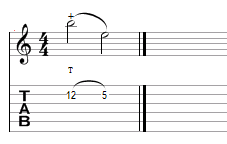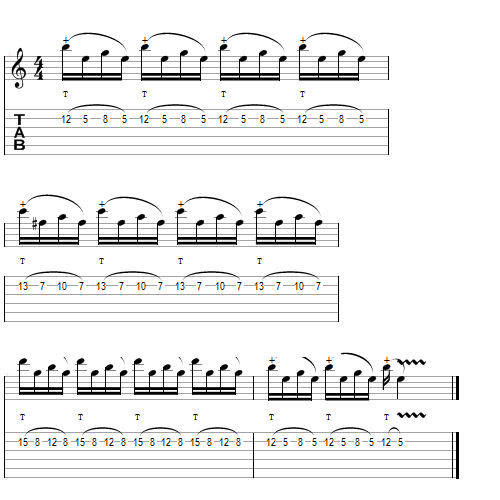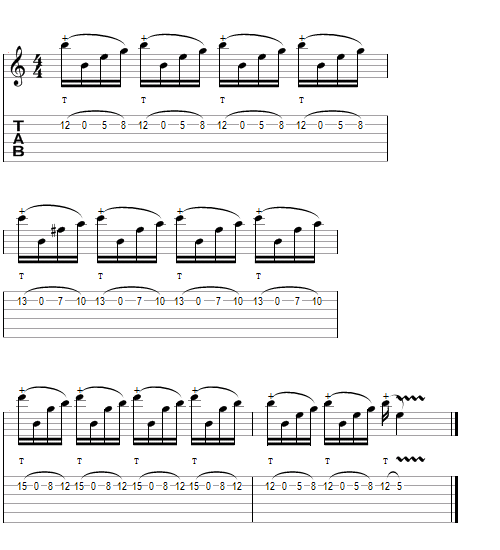What is tapping?
Tapping is a method in which we can play long legato phrases that would normally be too difficult to play by stretching the hand. Normally when we use hammer-ons and pull offs we don’t need to stretch to far. But what happens if we want to pull off from the 12th fret too the 5th? Even for the biggest hands this is going to be very difficult.
So instead we tap.
Lets have a look at that example, pulling off from the 12th fret to the 5th.

We can recognise the arched line indicating we need to pull off to the 5th fret. But how do we pull off so far? We can’t stretch our hand that far unless you’re some kind of yeti.
Lets pay attention to the 12th fret b note in the tab. Notice a small ‘t’ above it in the tab. That’s telling us to play that note not with our fretting hand but to tap it with our picking hand.
What is a tap?
Using a finger from your picking hand, usually the middle finger, tap down on that fret as if you are tapping a key on a keyboard. Hold the note for as long as you need then release it. When we release the tap we will pull off onto the note behind it.
In our example we tap onto the 12th fret of the b string with our picking hand middle finger, hold for half a bar, then release it. But before we released it, we made sure to press down that note on the 5th fret. This way once we let go of the 12th fret the 5th fret will sound.
Since we’re not picking any notes it may be more difficult to get the notes to ring loudly or sustain. There are a few tips to help with this,
Use a good amount of distortion, high levels of gain and drive will make your guitar more sensitive to lighter touches.
Tap firmly, don’t smash the fret with your finger but press firmly and make good contact.
Pull off at angles. When pulling off instead of lifting you finger directly away from the fret board. Lift your fingers off at an angle, so they move slightly toward the floor. This adds more energy to the strings and makes them ring louder and longer.
High output pickups, the hotter the signal coming from your guitar the better.
Generally speaking, a good amount of drive or distortion and a reasonably high output guitar is more than enough to get a good tapping sound. If you have both of these and the sound is weak then you need to adjust your technique. Some players can even get a strong tapping sound from an acoustic guitar using very clean and strong technique.
Try that very simple example above, it should sound something like this,
By tapping we can construct whole licks and phrases using this method. Here is a more complicated and fun example,

Now instead of just pulling off we are adding hammer-ons also. Lets look at the first bar. We tap onto the 12th fret, pull of onto the 5th fret and then still using our fretting hand hammer onto the 8th fret in the normal manner. And finally we pull off from that note back to the 5th fret in a normal manner. We repeat that four times in the 1st bar. The rest of the lick moves up neck sticking to the same idea. The lick finishes with a single tap and pull off to a ‘e’ note. The whole lick sticks to notes chosen from E minor to give it some musical framework. This type of lick is very common bread and butter style tapping lick where each little tapping phrase is grouped into four notes.
Try this lick very slowly at first. You can hear how it sounds played very slowly.
At a faster speed it will sound like this.
When playing any kind of tapping lick it is important not to snatch at the tapped note and rush it. In the example we just looked at we can see that the tapped note should last the same amount of time as the other notes. It can be easy to rush the tapped note and move too quickly to the next note. As with anything in guitar playing, start slowly and speed up gradually. This will help get everything nice and even.
Sometimes when tapping guitarists like to use open strings, here is an example

It is very similar to the previous example in its positions, but this time we use open strings. Lets look at the 1st bar. We tap onto the 12th fret and then pull off onto the open string. Then using our fretting hand we hammer onto the 5th fret then hammer onto the 8th. And we move up the neck finally finishing with that ‘e’ note again. This lick is also in E minor.
Try it slow,
And if you like fast
Both those examples tap along one string. A harder thing to do is to tap across two strings. Here is an example.

This lick is in E minor again also. We play that familiar lick in the 1st bar and then move to the top e string. Lucky for us keeping to E minor gives us the same pattern just on a different string. We repeat this twice then finish with a tap to the ‘e’ note to finish.
Listen to it slow,
And fast
These examples are just simple ideas all in E minor. If you liked the sound of tapping licks try constructing your own in other keys. Maybe use more strings?
These examples are fairly long tapping licks, but it’s also common in music to use a odd single tap among a phrase, when you just want to get a long distance hammer or pull off just the once. You can also tap bent notes. Try bending up a note and then tapping the same string further up the neck.
Have fun!
- Tapping is required for long legato stretches.
- Dont snatch at a tap, make sure to keep in time.
- A bit of distortion helps.
- Tapping licks can be played accross and along strings.
- Focus on good legato techniques.
